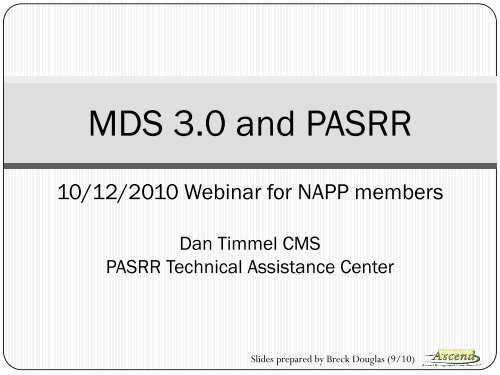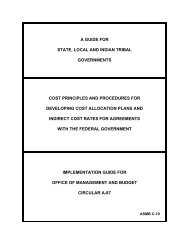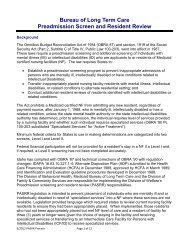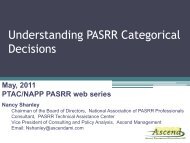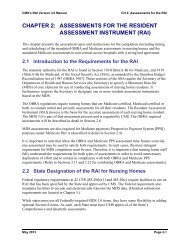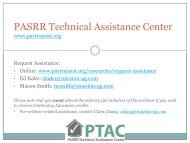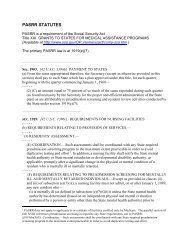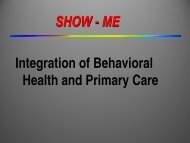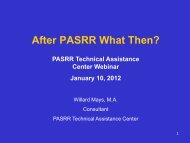MDS 3.0 and PASRR - PASRR Technical Assistance Center
MDS 3.0 and PASRR - PASRR Technical Assistance Center
MDS 3.0 and PASRR - PASRR Technical Assistance Center
- No tags were found...
Create successful ePaper yourself
Turn your PDF publications into a flip-book with our unique Google optimized e-Paper software.
<strong>MDS</strong> <strong>3.0</strong> <strong>and</strong> <strong>PASRR</strong>10/12/2010 Webinar for NAPP membersDan Timmel CMS<strong>PASRR</strong> <strong>Technical</strong> <strong>Assistance</strong> <strong>Center</strong>Slides prepared by Breck Douglas (9/10)
Agenda• What is <strong>MDS</strong>? How <strong>and</strong> why does it affect me?• Review <strong>MDS</strong> <strong>3.0</strong> changes related to <strong>PASRR</strong>• How will <strong>MDS</strong> <strong>3.0</strong> affect Change in Status Evaluations• Review criteria for Change in Status Evaluations• Questions <strong>and</strong> answers• Resources2
What is <strong>MDS</strong>?• <strong>MDS</strong>: Minimum Data Set. Actually quite a robust set of data onevery resident in Medicaid certified nursing facilities.• The <strong>MDS</strong> is a powerful tool for implementing st<strong>and</strong>ardizedassessment <strong>and</strong> for facilitating care management in nursinghomes (NHs)... Its content has implications for residents,families, providers, researchers, <strong>and</strong> policymakers (CMS, 2010).• The <strong>MDS</strong> assessment is completed at admission <strong>and</strong> then onceevery quarter, <strong>and</strong> upon a significant change, for all NFresidents. The assessment is used in care planning.https://www.cms.gov/NursingHomeQualityInits/25_NHQI<strong>MDS</strong>30.asp#TopOfPage3
A view of page one of the <strong>MDS</strong> <strong>3.0</strong>, <strong>and</strong> thenew <strong>PASRR</strong> question on page three:4
How will <strong>MDS</strong> <strong>3.0</strong> affect me?• <strong>MDS</strong> <strong>3.0</strong> is designed to improve the reliability, accuracy, <strong>and</strong>usefulness of the <strong>MDS</strong>. These improvements support the intent that<strong>MDS</strong> be a tool to improve clinical assessments.• <strong>MDS</strong> <strong>3.0</strong> issued by nursing facilities starting October 1, 2010.• New to <strong>MDS</strong> <strong>3.0</strong> is question A1500 which documents if a <strong>PASRR</strong>Level II determination has been issued.• This is the first time <strong>PASRR</strong> has been specifically addressed in the <strong>MDS</strong> process <strong>and</strong>will bring individuals identified by <strong>PASRR</strong> to heightened awareness.5
<strong>MDS</strong> <strong>3.0</strong> <strong>PASRR</strong> Item A15506CONFIDENTIAL
How will <strong>MDS</strong> <strong>3.0</strong> affect <strong>PASRR</strong>?• Better defined scenarios for nursing facilities illustrating whena change in status (CoS) may require <strong>PASRR</strong> evaluation shouldlead in most states to an increase in referrals from NFs:• For Level II resident reviews for persons already identifiedthrough <strong>PASRR</strong>, (A1500 = Yes) whenever the residentexperiences a significant Change of Status (CoS)• For Level II evaluations for NF residents with newly identified orsuspected SMI, ID or DD who have never before been identifiedthrough <strong>PASRR</strong>, when the resident experiences a significantChange of Status (CoS)7
<strong>MDS</strong> <strong>3.0</strong> instructs NF staff that…•If an <strong>MDS</strong> significant change in statusassessment (SCSA) is completed for a residentfor whom A1500 is YES, or for whom mentalillness, mental retardation, or a relatedcondition is suspected, then a referral to thestate mental health or mental retardationauthority is required, for possible ResidentReview, a Level II evaluation.8
<strong>MDS</strong> triggered Level II referrals• The purpose of this instruction is to make therelationship explicit between the facility’sobligation to perform SCSAs under <strong>MDS</strong> <strong>3.0</strong>, <strong>and</strong>the facility’s obligation under <strong>PASRR</strong> to refer forpossible Level II Resident Reviews.• The instruction is not an <strong>MDS</strong> requirement but apractical instruction to facilities about how theycan meet their <strong>PASRR</strong> obligation whileperforming <strong>MDS</strong> activities.9
<strong>MDS</strong> triggered Level II referrals• The challenge is that NF staff have not been able todetermine whether the individual requires a first timeor an updated Resident Review. So the law at§1919(e)(7)(B)(iii) of the Social Security Act is broad<strong>and</strong> says that all CoS should be referred for Level IIevaluation.• State agencies may wish to collaborate on developingsome criteria permitting facilities to omit referralsunder certain conditions not related to <strong>PASRR</strong>10CONFIDENTIAL
How might this affect your <strong>PASRR</strong> program?• Plan for a likely increase in CoS Level II evaluation referrals• Possible need for a process to review requests for CoS LevelII evaluations sent by nursing facilities as a result of <strong>MDS</strong> <strong>3.0</strong>• It is possible that not all requests will need a full <strong>PASRR</strong>evaluation:• For some requests, you will thank the NF for their diligence, <strong>and</strong> explainwhy a Level II <strong>PASRR</strong> is not needed• For some you may gather information <strong>and</strong> update the extant <strong>PASRR</strong>Summary of Findings• For some requests you may initiate a full comprehensive Level IIevaluation <strong>and</strong> issue a new Summary of Findings11
Criteria for CoS referral for RRReferral for RR evaluations are required for residents previously identified by<strong>PASRR</strong> in any of the following circumstances: (Please note this is not anexhaustive list.)• transferred, admitted, or readmitted to a NF following an inpatient psychiatric stay orequally intensive treatment.• increased behavioral, psychiatric, or mood-related symptoms.• behavioral, psychiatric, or mood related symptoms have not responded to ongoingtreatment.• an improved medical condition, that may require modifying the plan of careor placement recommendations. See example• CoS is physical, but behavioral, psychiatric, or mood-related symptoms, or cognitiveabilities, may influence adjustment to an altered pattern of daily living.• indicates a preference (may be communicated verbally or through other forms ofcommunication, including behavior) to leave the facility.• condition or treatment is or will be significantly different than described inthe resident’s most recent <strong>PASRR</strong> Level II evaluation <strong>and</strong> determination. Seeexample12
CoS example: Improvedmedical conditionExample: an improved medical condition, such that theresident’s plan of care or placement recommendations mayrequire modifications.Mr. L has a diagnosis of serious mental illness, but his primary reasonfor admission was rehabilitation following a hip fracture. Once thehip fracture resolves <strong>and</strong> the he becomes ambulatory, even if otherconditions exist for which Mr. L receives medical care, he should bereferred for a <strong>PASRR</strong> evaluation to determine whether a change inhis placement or services is needed.13
CoS example: Prior LII outcome isno longer appropriateExample: condition or treatment significantly differentthan described in the resident’s most recent <strong>PASRR</strong>Level II evaluation <strong>and</strong> determination :• Ms. K has mental retardation. She is normally cooperative,but after she sustains a fall requiring a cast, she has becomeagitated <strong>and</strong> combative with the physical therapist <strong>and</strong> withstaff who try to clean the area. She does not underst<strong>and</strong> whyher normal routine has changed <strong>and</strong> why staff needs to toucha painful area of her body.14
Criteria for COS evaluations: Residentsnot previously identified by <strong>PASRR</strong>Referral for Level II Resident Review evaluations are requiredfor residents who may not have previously been identifiedby <strong>PASRR</strong> to have mental illness, mental retardation, or acondition related to mental retardation in the followingcircumstances: (Please note this is not an exhaustive list.)• exhibits behavioral, psychiatric, or mood related symptomssuggesting the presence of a diagnosis of mental illness (<strong>and</strong>dementia is not the primary diagnosis).• mental retardation or condition related to mental retardation wasnot previously identified <strong>and</strong> evaluated through <strong>PASRR</strong>.• transferred, admitted, or readmitted to a NF following an inpatientpsychiatric stay or equally intensive treatment.15
Questions <strong>and</strong> answers16CONFIDENTIAL
What’s next?• Educate NFs in your state about change of statusguidelines.• Ensure NFs know who to contact when they believea <strong>PASRR</strong> CoS resident review might be necessary.• Create a notification form that allows your state toidentify trends <strong>and</strong> analyze in status changereporting• Be ready to use the data available under <strong>MDS</strong> <strong>3.0</strong>!17
ResourcesCMS <strong>MDS</strong> <strong>PASRR</strong> training slides <strong>and</strong> The Assessment Schedule for theRAI:https://www.cms.gov/NursingHomeQualityInits/45_NHQI<strong>MDS</strong>30TrainingMaterials.aspYou tube video of <strong>MDS</strong> section A training:http://www.youtube.com/watch?v=mlAlVKVY21IVideo for interviewing vulnerable eldershttp://www.youtube.com/watch?v=mlAlVKVY21I• Slides prepared by Breck Douglas (9/10)


